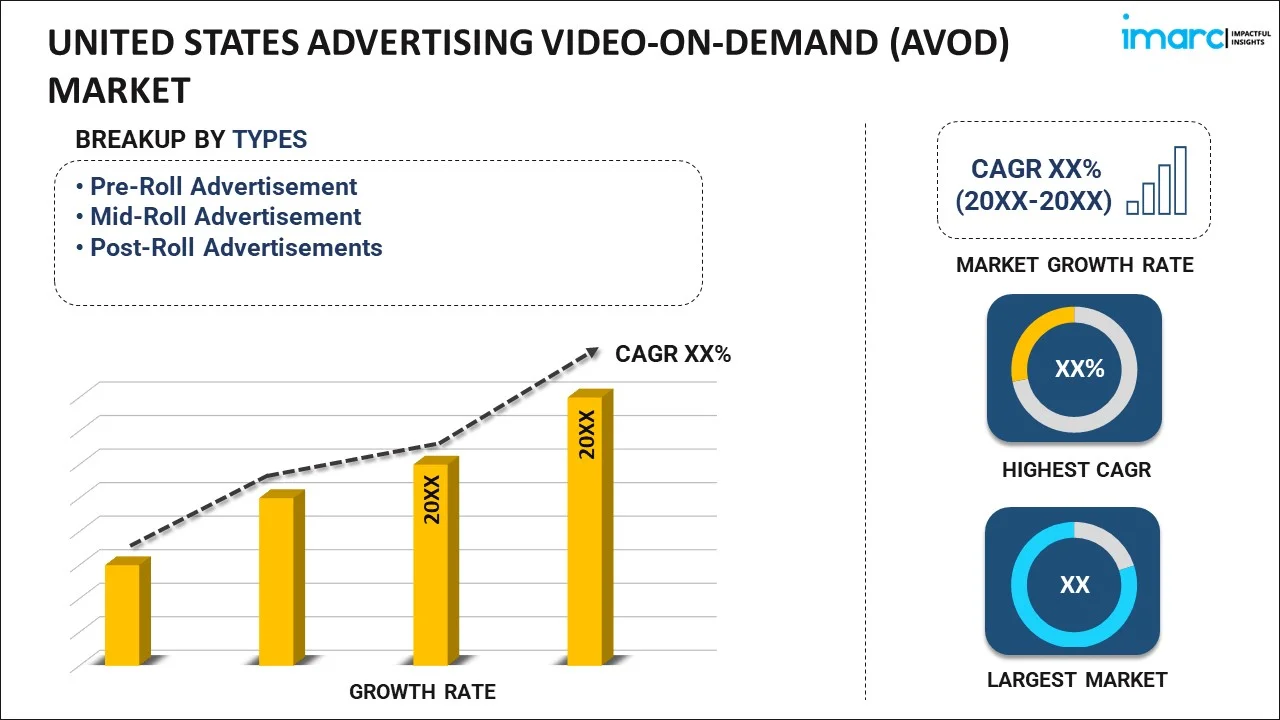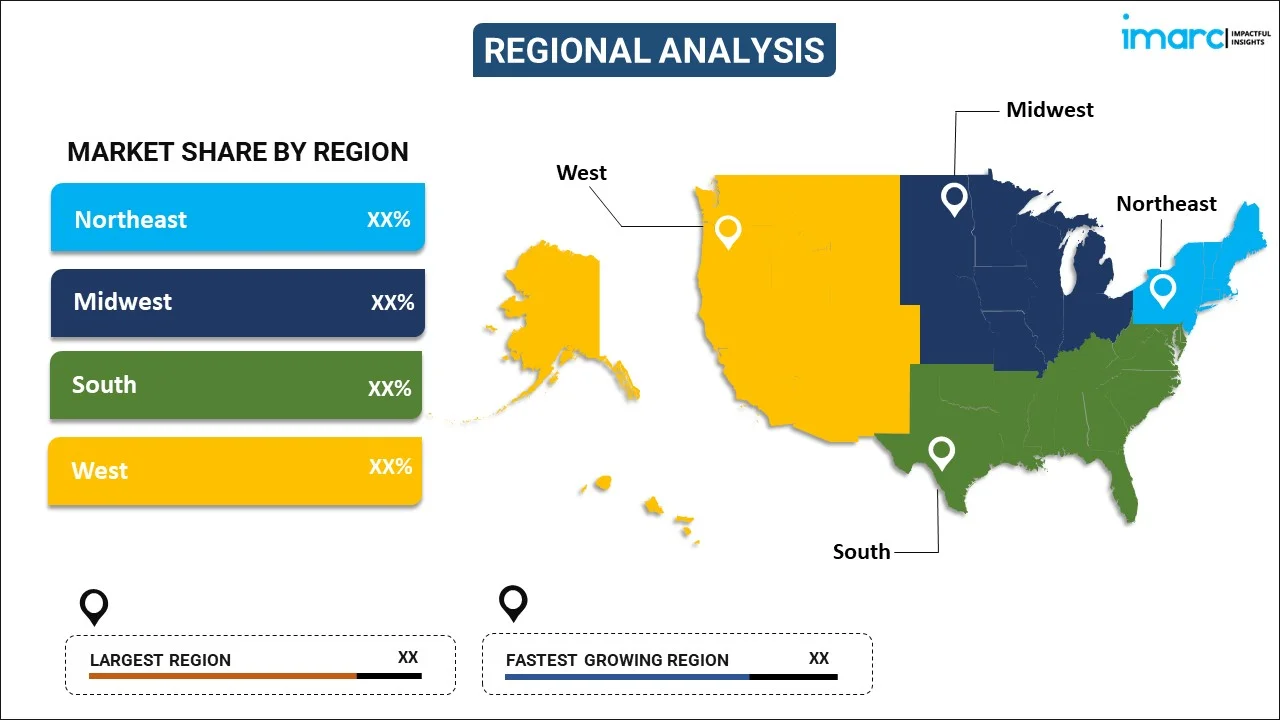
United States Advertising Video-On-Demand (AVOD) Market Report by Type (Pre-Roll Advertisement, Mid-Roll Advertisement, Post-Roll Advertisements), Streaming Device (Smart TVs, Laptops and Desktops, Smartphones and Tablets, and Others), Content (Media and Entertainment, Music, Travel and Tourism, Sports, and Others), Solution Type (Pay TV on Demand, Over the Top, and Others), and Region 2025-2033
Market Overview:
The United States advertising video-on-demand (AVOD) market size reached USD 15.0 Billion in 2024. Looking forward, IMARC Group expects the market to reach USD 125.8 Billion by 2033, exhibiting a growth rate (CAGR) of 24.6% during 2025-2033. The market growth is driven by internet accessibility, diverse device usage, cost-effectiveness, targeted advertising, the rising trend of binge-watching, the increasing production of original content, and strategic partnerships, which is establishing AVOD as a dynamic platform for content consumption and revenue generation.
|
Report Attribute
|
Key Statistics
|
|---|---|
|
Base Year
|
2024 |
|
Forecast Years
|
2025-2033 |
|
Historical Years
|
2019-2024
|
| Market Size in 2024 | USD 15.0 Billion |
| Market Forecast in 2033 | USD 125.8 Billion |
| Market Growth Rate (2025-2033) | 24.6% |
Advertising Video-On-Demand (AVOD) is a digital content delivery model that enables users to access video content over the internet, typically for free or at a reduced cost, in exchange for viewing advertisements. AVOD offers a convenient and flexible way for viewers to stream a wide range of video content, including movies, TV shows, and other media. This model benefits both consumers and content providers, as users can enjoy content without upfront fees, while content creators generate revenue through advertising placements. AVOD platforms strategically insert advertisements throughout the video playback, such as pre-roll, mid-roll, or post-roll ads, allowing advertisers to target specific audiences based on user preferences and demographics. As the AVOD market evolves, the industry is witnessing ongoing trends in terms of content consumption patterns, advertising strategies, and the expansion of compatible streaming devices.
United States Advertising Video-On-Demand (AVOD) Market Trends:
The growth of AVOD market in the United States is being propelled by the increasing penetration of high-speed internet and the widespread adoption of smartphones, smart TVs, and other connected devices. This surge in digital connectivity has expanded the potential audience base, allowing AVOD platforms to reach a diverse demographic. Additionally, the cost-effective nature of AVOD, where viewers access content for free or at a reduced cost in exchange for advertisements, has garnered attention from consumers seeking accessible entertainment options. Moreover, the AVOD model offers advertisers a targeted approach to reaching their desired audience segments, enhancing the effectiveness of their marketing efforts. Furthermore, the increasing preference for on-demand content has driven viewers away from traditional cable TV toward AVOD platforms. This shift is facilitated by the trend of "binge-watching," where viewers consume multiple episodes or movies in one sitting, aligning well with AVOD's content availability and accessibility. Industry players are also investing in original content, enhancing the appeal of AVOD platforms and attracting users seeking fresh and exclusive programming.
United States Advertising Video-On-Demand (AVOD) Market Segmentation:
IMARC Group provides an analysis of the key trends in each segment of the United States advertising video-on-demand (AVOD) market report, along with forecasts at the country level for 2025-2033. Our report has categorized the market based on type, streaming device, content, and solution type.
Type Insights:

- Pre-Roll Advertisement
- Mid-Roll Advertisement
- Post-Roll Advertisements
The report has provided a detailed breakup and analysis of the market based on the type. This includes pre-roll advertisement, mid-roll advertisement, and post-roll advertisements.
Streaming Device Insights:
- Smart TVs
- Laptops and Desktops
- Smartphones and Tablets
- Others
A detailed breakup and analysis of the market based on the streaming device has also been provided in the report. This includes smart TVs, laptops and desktops, smartphones and tablets, and others.
Content Insights:
- Media and Entertainment
- Music
- Travel and Tourism
- Sports
- Others
The report has provided a detailed breakup and analysis of the market based on the content. This includes media and entertainment, music, travel and tourism, sports, and others.
Solution Type Insights:
- Pay TV on Demand
- Over the Top
- Others
A detailed breakup and analysis of the market based on the solution type has also been provided in the report. This includes pay TV on demand, over the top, and others.
Regional Insights:

- Northeast
- Midwest
- South
- West
The report has also provided a comprehensive analysis of all the major regional markets, which include Northeast, Midwest, South, and West.
Competitive Landscape:
The report has also provided a comprehensive analysis of the competitive landscape in the market. Competitive analysis such as market structure, key player positioning, top winning strategies, competitive dashboard, and company evaluation quadrant has been covered in the report. Also, detailed profiles of all major companies have been provided.
United States Advertising Video-On-Demand (AVOD) Market Report Scope:
| Report Features | Details |
|---|---|
| Base Year of the Analysis | 2024 |
| Historical Period | 2019-2024 |
| Forecast Period | 2025-2033 |
| Units | Billion USD |
| Scope of the Report | Exploration of Historical and Forecast Trends, Industry Catalysts and Challenges, Segment-Wise Historical and Predictive Market Assessment:
|
| Types Covered | Pre-Roll Advertisement, Mid-Roll Advertisement, Post-Roll Advertisements |
| Streaming Devices Covered | Smart TVs, Laptops and Desktops, Smartphones and Tablets, Others |
| Contents Covered | Media and Entertainment, Music, Travel and Tourism, Sports, Others |
| Solution Types Covered | Pay TV on Demand, Over the Top, Others |
| Regions Covered | Northeast, Midwest, South, West |
| Customization Scope | 10% Free Customization |
| Post-Sale Analyst Support | 10-12 Weeks |
| Delivery Format | PDF and Excel through Email (We can also provide the editable version of the report in PPT/Word format on special request) |
Key Questions Answered in This Report:
- How has the United States advertising video-on-demand (AVOD) market performed so far and how will it perform in the coming years?
- What has been the impact of COVID-19 on the United States advertising video-on-demand (AVOD) market?
- What is the breakup of the United States advertising video-on-demand (AVOD) market on the basis of type?
- What is the breakup of the United States advertising video-on-demand (AVOD) market on the basis of streaming device?
- What is the breakup of the United States advertising video-on-demand (AVOD) market on the basis of content?
- What is the breakup of the United States advertising video-on-demand (AVOD) market on the basis of solution type?
- What are the various stages in the value chain of the United States advertising video-on-demand (AVOD) market?
- What are the key driving factors and challenges in the United States advertising video-on-demand (AVOD)?
- What is the structure of the United States advertising video-on-demand (AVOD) market and who are the key players?
- What is the degree of competition in the United States advertising video-on-demand (AVOD) market?
Key Benefits for Stakeholders:
- IMARC’s report offers a comprehensive quantitative analysis of various market segments, historical and current market trends, market forecasts, and dynamics of the United States advertising video-on-demand (AVOD) market from 2019-2033.
- The research study provides the latest information on the market drivers, challenges, and opportunities in the United States advertising video-on-demand (AVOD) market.
- Porter's five forces analysis assist stakeholders in assessing the impact of new entrants, competitive rivalry, supplier power, buyer power, and the threat of substitution. It helps stakeholders to analyze the level of competition within the United States advertising video-on-demand (AVOD) industry and its attractiveness.
- Competitive landscape allows stakeholders to understand their competitive environment and provides an insight into the current positions of key players in the market.
Need more help?
- Speak to our experienced analysts for insights on the current market scenarios.
- Include additional segments and countries to customize the report as per your requirement.
- Gain an unparalleled competitive advantage in your domain by understanding how to utilize the report and positively impacting your operations and revenue.
- For further assistance, please connect with our analysts.
 Inquire Before Buying
Inquire Before Buying
 Speak to an Analyst
Speak to an Analyst
 Request Brochure
Request Brochure
 Request Customization
Request Customization




.webp)




.webp)












